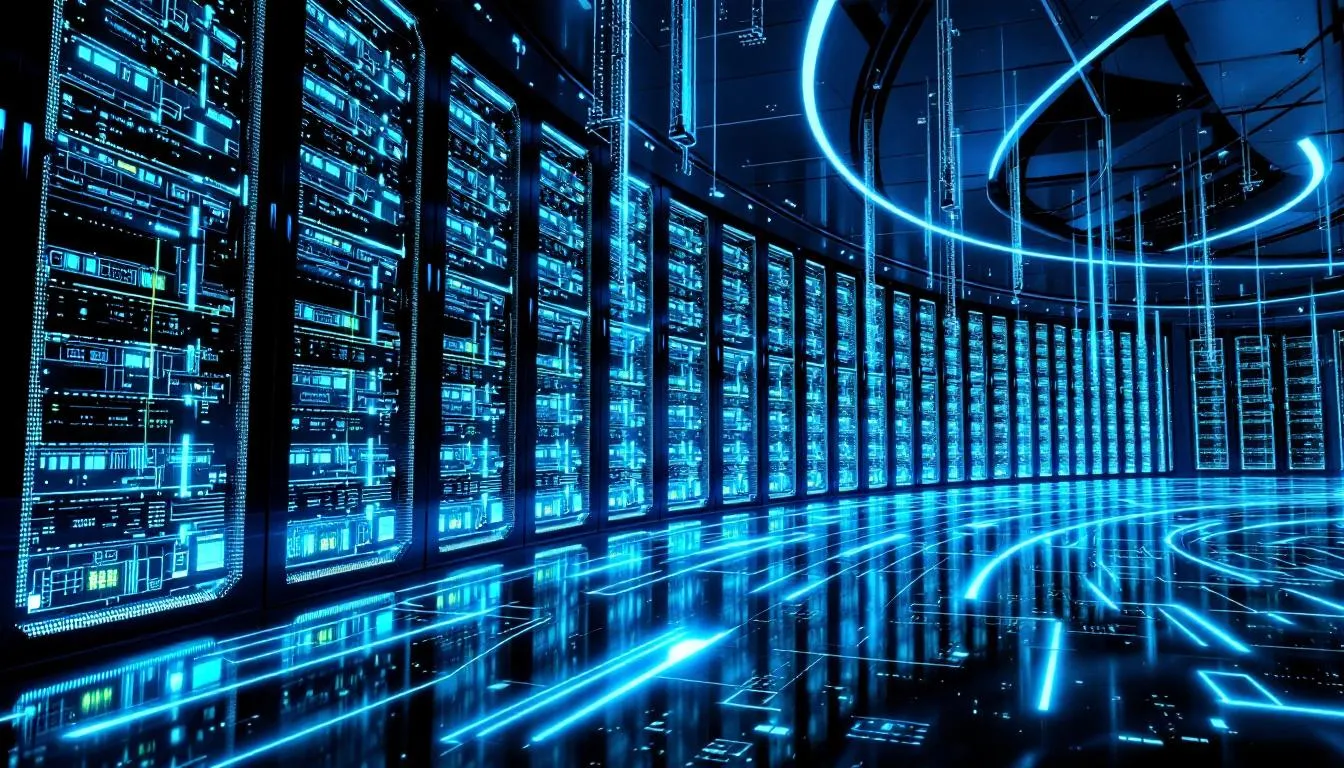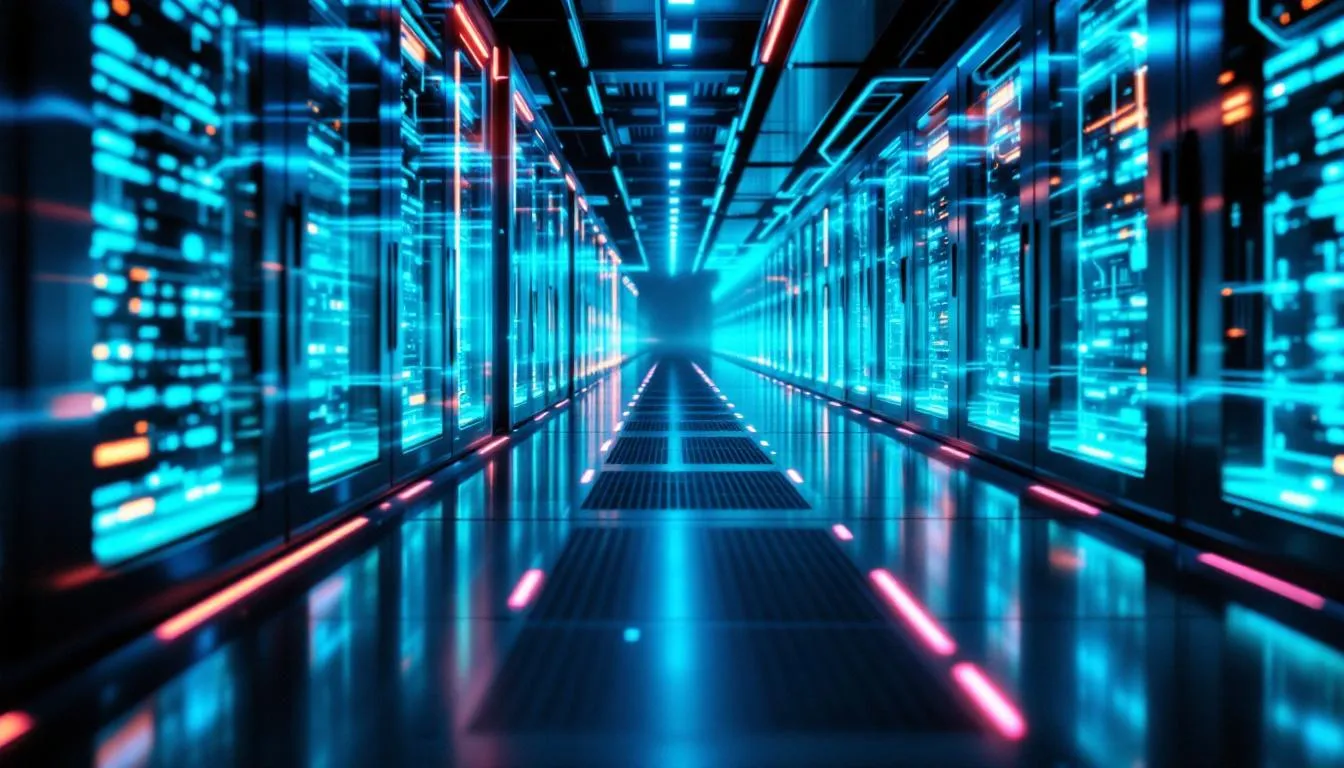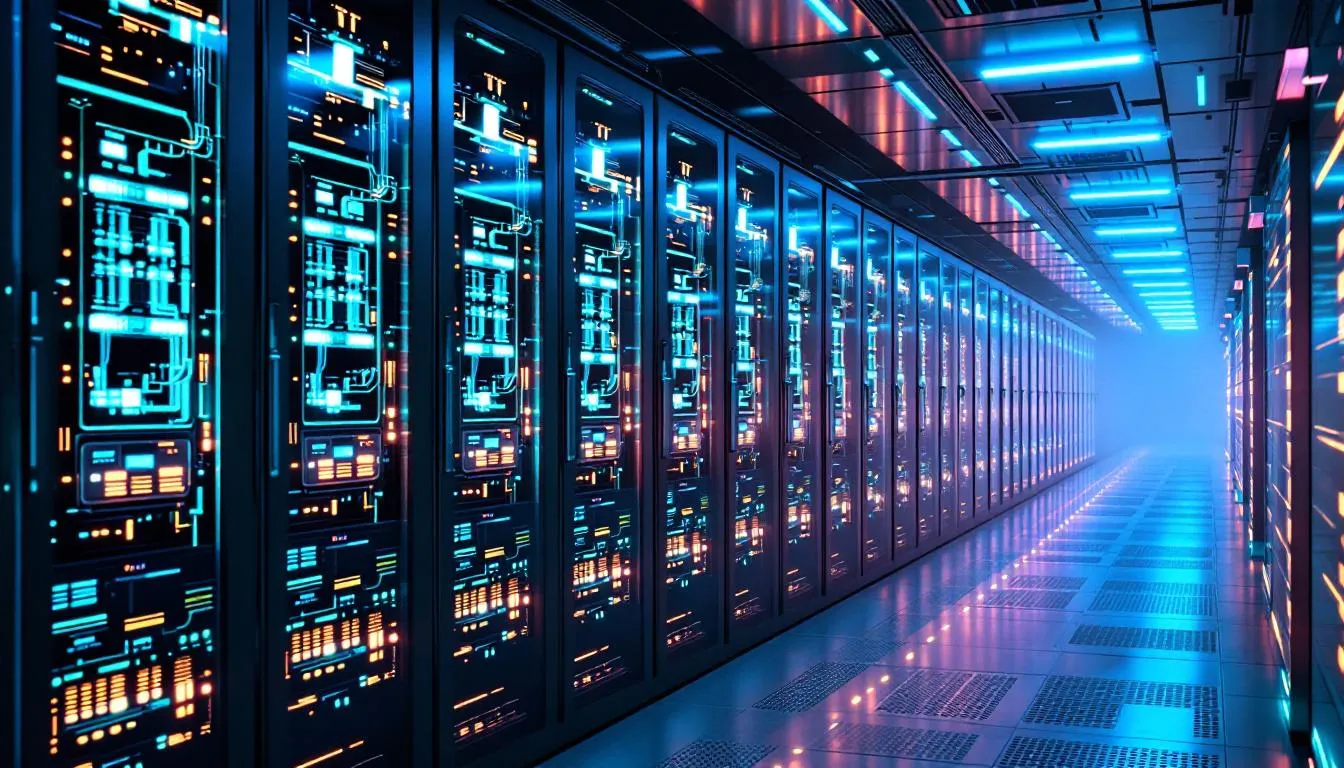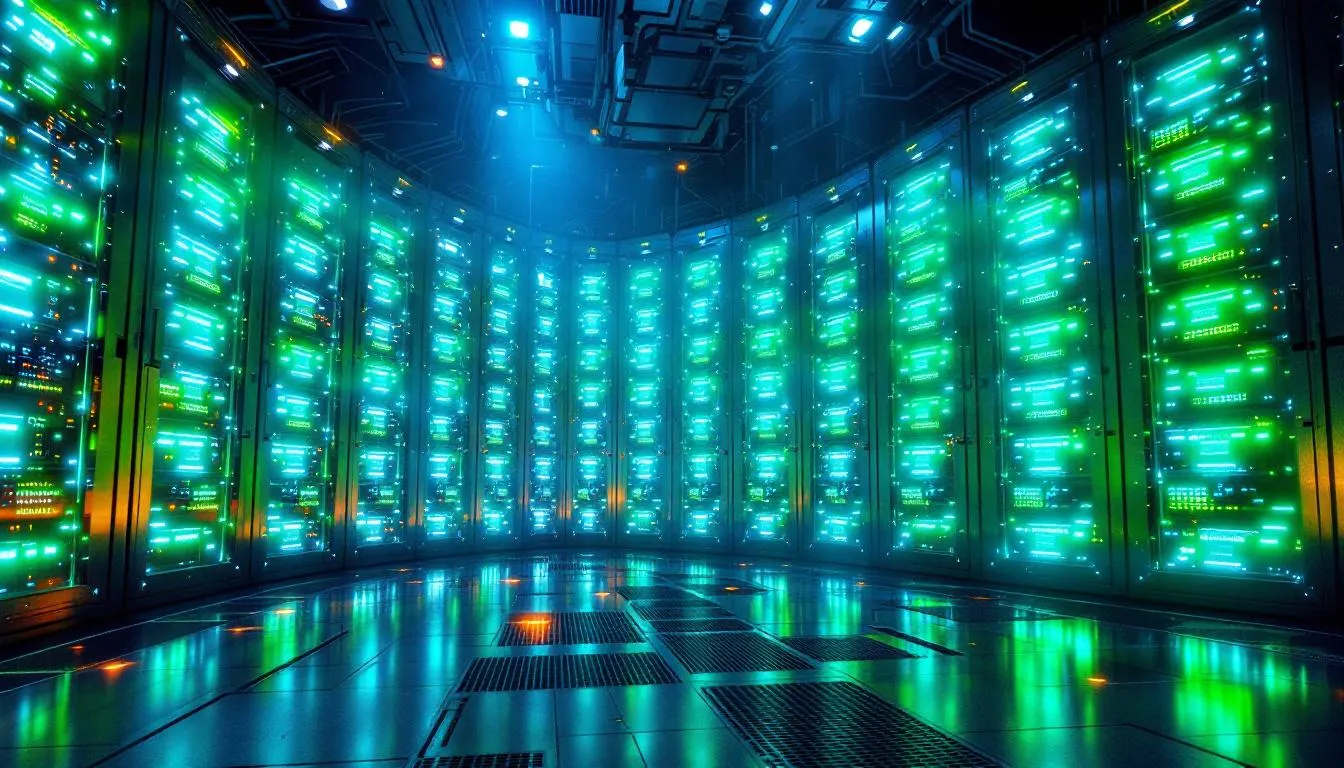Data center data includes vital statistics, infrastructure components, security measures, and industry trends. This article explores these elements to give you a clear picture of the modern data center landscape.
Key Takeaways
- The global data center market is rapidly expanding, projected to reach $452.53 billion in revenue by 2025 and $624.07 billion by 2029, highlighting strong demand for digital services.
- Data center infrastructure comprises critical components such as servers, storage systems, and network connectivity, all essential for seamless operations and high performance.
- Enhancing security through both physical and cybersecurity measures is crucial for protecting data centers, which also face significant environmental challenges and a growing need for sustainable practices.
Key Data Center Statistics

The global data center market is experiencing unprecedented growth. In 2024, it generated a staggering $344 billion in revenue, with projections suggesting it will soar to $452.53 billion by 2025. This rapid expansion underscores the vital role data centers play in the modern economy, supporting everything from cloud computing to large-scale data storage solutions.
The United States leads the world in the number of data centers, boasting an impressive total of 5,426 as of March 2025. This dominance highlights the country’s pivotal role in the global data center landscape, driven by a robust demand for digital services and infrastructure, particularly in most data centers. Key points include:
- The U.S. has 5,426 data centers as of March 2025.
- This leadership reflects strong demand for digital services and infrastructure.
- The average monthly asking rate for data center space in primary markets increased by 12.6% year-over-year in 2024, indicating growing demand for these facilities.
The data center market is expected to expand at an annual growth rate of 8.37% from 2025 to 2029, potentially reaching $624.07 billion. This sustained growth trajectory indicates a thriving industry with ample opportunities for investment and innovation. Additionally, the modular data center market is projected to grow significantly, reaching $111.3 billion by 2032.
These statistics paint a clear picture of the dynamic and rapidly evolving data center industry. Delving into components, security measures, and environmental impacts reveals that data centers are at the heart of the digital revolution.
Data Center Infrastructure Components
At the core of any data center lies its infrastructure, a sophisticated network of data center components designed to ensure seamless operations and robust performance. Servers, the backbone of a data center, provide the processing power and memory essential for delivering applications, services, and data center equipment to end-user devices.
Storage systems in data centers are equally critical. They can be categorized into NAS (Network Attached Storage) for multiple server access and SAN (Storage Area Network) for shared storage over separate networks, each serving distinct operational needs. These storage services ensure that data is readily available and securely stored, meeting the diverse requirements of modern enterprises and supporting robust storage infrastructure.
Network infrastructure is another vital component, connecting servers and storage systems while providing essential external network connectivity. This digital infrastructure facilitates efficient data transfer and operations, ensuring that data centers can handle large volumes of traffic and maintain high performance with network equipment.
Additionally, cooling systems, including computer room air conditioning units, are essential for maintaining optimal temperatures within data centers, preventing the overheating of IT equipment. Together, these components form the backbone of data center infrastructure, enabling the seamless operation of modern data centers.
As we move forward, we will explore the measures in place to secure these critical facilities from various threats.
Data Center Security Measures
The security of data centers is paramount due to the sensitive nature of the data they house. Data center security encompasses a range of measures, including physical security, access controls, and cybersecurity protocols. These measures collectively safeguard data centers from physical and digital threats.
Physical security in data centers often involves advanced measures such as biometric scanners and electronic locks to restrict access control to authorized personnel only. These controls are essential in protecting the physical assets within the physical facility and the physical locations from unauthorized access and potential tampering in the physical space.
Cybersecurity is equally critical, with firewalls and intrusion protection systems serving as the first line of defense against cyber threats. Hyperscale data centers, which handle vast amounts of data, require specialized firewalls and enhanced cybersecurity protocols to ensure robust protection. These measures are designed to detect and prevent unauthorized access, ensuring the integrity and confidentiality of the data.
A comprehensive security strategy that includes both physical and cybersecurity measures ensures data centers are protected from a wide range of threats. As we continue, we will examine the environmental impact of these facilities and the steps being taken to mitigate it.
Data Center Environmental Impact

Data centers, while essential for the digital economy, have a significant environmental footprint. In 2023, data centers accounted for 4.4% of the total U.S. electricity consumption. This high energy demand is projected to increase, with data centers expected to consume up to 130 gigawatts of electricity by 2030.
Cooling systems represent a substantial portion of this energy use, accounting for about 38% of a typical data center’s total energy consumption. The reliance on fossil fuels for new data center developments contributes to higher carbon emissions, with data centers responsible for emitting around 105 million metric tons of carbon annually. To reduce energy consumption, the average carbon intensity of data centers is about 548 grams of CO2 equivalent per kilowatt-hour.
Companies are increasingly integrating renewable energy solutions into data center designs to address these environmental challenges. Natural gas is being used as a bridge fuel to meet rising energy demands while transitioning to renewable sources. Additionally, nuclear energy, particularly small modular reactors, is gaining traction as a potential sustainable power source for data centers.
As society moves towards more sustainable practices, the data center industry must continue to innovate and adopt green data centers technologies. Next, we will explore the role of cloud data centers and virtualization in modern data infrastructure.
Cloud Data Centers and Virtualization

Cloud data centers have revolutionized the IT landscape by offering scalable and efficient computing solutions over the Internet. These facilities, operated by major cloud service providers, can process massive data volumes and support a wide range of applications and services, including ibm cloud, cloud computing data centers, cloud services, large data centers, data center services, and cloud providers.
The shift from traditional physical servers to virtual networks and multicloud environments has significantly enhanced resource utilization in data centers. Virtualization technologies allow for the creation of Software-Defined Data Centers (SDDC), where components are virtualized and delivered as services. This approach reduces the need for physical hardware and minimizes idle capacity, leading to more efficient operations and better management of data center resources.
Automation and orchestration further streamline resource management in virtualized environments, reducing manual tasks and enhancing overall efficiency. The rise of artificial intelligence and the Internet of Things (IoT) has driven the need for more advanced infrastructure and operational capabilities.
The deployment of modular and prefabricated multiple data centers allows for faster data center construction and scalability, meeting the demands of emerging technologies. As we continue, we will explore the importance of redundancy and disaster recovery strategies in data centers.
Redundancy and Disaster Recovery
Redundancy is a crucial aspect of data center design, ensuring that operations can continue seamlessly in the event of disruptions. Implementing redundancy in systems can significantly enhance uptime and protect against natural disasters and equipment failures, as noted by the Uptime Institute.
Redundancy and backup strategies include:
- N+1 redundancy, where there is one backup for every critical component, allowing for some component failures without causing downtime.
- Tier 4 data centers, designed for maximum fault tolerance with multiple backups ensuring high availability.
- Backup redundancy strategies such as data replication and offsite backups, providing additional layers of protection against data loss.
Regularly testing backup systems and disaster recovery plans ensures they function correctly during emergencies. Power redundancy involves multiple power sources, ensuring data center operations continue even during outages. Cooling redundancy is also crucial to prevent equipment overheating, involving backup cooling systems and uninterruptible power supplies ups and power subsystems.
By implementing robust redundancy and disaster recovery strategies, data centers can maintain high availability and protect against various disruptions. Next, we will discuss best practices for managing data centers effectively.
Data Center Management Best Practices
Effective data center management is essential for maintaining optimal performance and minimizing downtime. The role of a data center manager includes responsibilities for maintenance, security, and compliance, ensuring the smooth operation of the facility.
Data center managers handle tasks like software and hardware upgrades, cleaning, and server arrangement. Deploying edge data centers can improve the overall efficiency of central data centers by offloading peak loads. Data Center Infrastructure Management (DCIM) software provides a comprehensive view of physical infrastructure, enhancing data center management. DCIM solutions offer a centralized platform to monitor and manage data center upgrades effectively.
Regular maintenance helps identify potential issues that could lead to system failures, while maintaining stable indoor climates reduces equipment wear. Other important practices include:
- Hiring well-trained staff or outsourcing maintenance to minimize downtime caused by human error.
- Keeping a clean environment in the data center to extend the life of the equipment.
- Practicing good data hygiene to help prevent overloading facility equipment.
By following these best practices, data center managers can ensure the efficient and reliable operation of their facilities. Next, we will explore the latest trends in data center design.
Trends in Data Center Design

Sustainability is becoming a critical factor in data center design, with operators needing to meet regulatory standards and societal expectations concerning energy consumption for critical applications. The rise of quantum computing is also influencing data center designs, requiring infrastructures that can support the specific needs of quantum systems.
Establishing edge data centers and internet data centers, along with other data centers, allows businesses to scale their infrastructure incrementally without significant upfront costs. These enterprise data center facility enhance data center’s transfer speeds and optimize bandwidth, which is crucial for applications requiring low latency, such as IoT and gaming.
Liquid cooling systems and air cooling are becoming increasingly vital in data centers to manage the rising power demands from advanced GPUs. Adopting these trends enhances efficiency and sustainability in data centers, meeting the demands of emerging technologies.
As we move forward, we will delve into the concept of edge data centers and their importance in the modern digital landscape.
Edge Data Centers
Edge data centers are designed to support edge computing and minimize latency, making them ideal for real-time, data-intensive workloads. These facilities facilitate localized processing, significantly decreasing the time it takes for data to travel, which leads to faster response times.
edge data centers enhance data transfer speeds and optimize bandwidth, which is crucial for applications that require low latency, such as IoT and gaming. Providing infrastructure close to users, edge data centers support real-time applications and boost overall performance.
With the growing demand for low-latency applications, edge data centers are becoming increasingly important in the digital economy, particularly in the Asia Pacific region. Next, we will explore the future of data centers and the trends shaping the industry.
Future of Data Centers

The market for data center transformation is projected to grow from $9 billion in 2023 to $20.8 billion by 2030, indicating a substantial shift in IT infrastructure strategies. This growth presents both significant investment opportunities and operational challenges for the industry.
2025 is projected to be a record year for data center development financing, with significant asset values needing funding. However, power transmission challenges are expected to worsen, causing delays in new data center developments. These challenges highlight the need for innovative solutions and strategic planning to ensure the continued growth and success of the data center industry.
As the industry evolves, new data centers will play an increasingly critical role in the digital economy, supporting the growth of emerging technologies and driving innovation in the term data center growth. Data centers important for this evolution will ensure that the infrastructure keeps pace with demand.
Summary
In summary, data centers are the backbone of the digital economy, supporting a wide range of applications and services. From their infrastructure components to security measures and environmental impacts, data centers play a crucial role in our daily lives.
As we look to the future, the data center industry will continue to evolve, driven by emerging technologies and the growing demand for digital services. By adopting sustainable practices and innovative solutions, data centers can meet the challenges of tomorrow and continue to drive technological advancements.
Frequently Asked Questions
What is the projected growth of the global data center market by 2025?
The global data center market is projected to grow to $452.53 billion by 2025, indicating substantial expansion in the sector.
How do data centers manage their energy consumption?
Data centers effectively manage their energy consumption through the implementation of renewable energy sources, advanced cooling systems, and rigorous energy management practices. This approach significantly minimizes their environmental footprint.
What is the role of virtualization in modern data centers?
Virtualization significantly enhances resource utilization in modern data centers by enabling the creation of virtual networks and multicloud environments, which reduces physical hardware reliance and boosts overall efficiency.
Why is redundancy important in data centers?
Redundancy is crucial in data centers as it enables continuous operations during disruptions, safeguarding against data loss and minimizing downtime through backup systems and disaster recovery strategies.
What are edge data centers, and why are they important?
Edge data centers play a vital role by enabling localized processing, which minimizes latency and enhances data transfer speeds, essential for real-time applications such as IoT and gaming. Their importance lies in delivering efficient and responsive services to end users.
